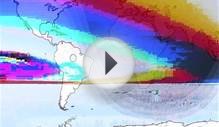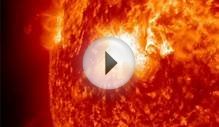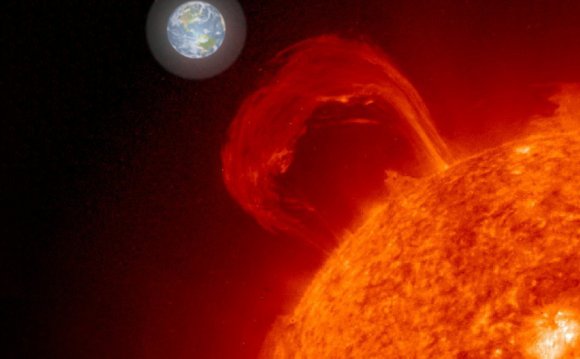
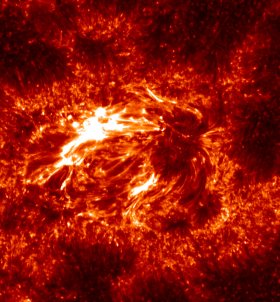 The completed IRIS observatory with solar arrays destroyed prior to launch.
The completed IRIS observatory with solar arrays destroyed prior to launch.
Nanoflare acceleration
The surface of the sun, or photosphere, is the region visible to human eyes. Above the photosphere lie the hotter chromosphere and transition regions, which emit ultraviolet light that can only be observed from space. This is because Earth's atmosphere absorbs most of this radiation before it reaches land-based instruments. The outer part of the solar atmosphere is called the corona.
While much of the sun's energy is generated in its core through hydrogen fusion, temperatures rise in the exterior layers moving out farther from the heat source. This means that something is powering that outer region, and scientists think the magnetic fields generated by the churning solar plasma provide at least part of the answer.
In emerging active regions, magnetic fields rise through the surface into the upper atmosphere, like a string pulled upward. When the energy carried by the field lines becomes too great, they snap, disconnecting from one another and reconnecting with other broken field lines in a process known as magnetic reconnection.
Paola Testa, of the Harvard-Smithsonian Center for Astrophysics, led a team that used IRIS to study the footprints of these loops, where he found that the intensity changed over a span of 20 to 60 seconds. Investigating possible causes, Testa determined that the variations were consistent with simulations of electrons generated from coronal nanoflares.
"Nanoflares are short heating events releasing amounts of energy about a billion times smaller than large flares, " Testa said.
Ultraviolet image of an active region on the sun, showing plasma at temperatures of 140, 000 degrees. This image was captured by NASA's IRIS spacecraft on Dec. 6, 2013.
Credit: IRIS: LMSAL, NASA. Courtesy Bart De Pontieu, Lockheed Martin Solar & Astrophysics Laboratory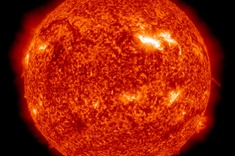 Although smaller than their larger cousins, nanoflares occur more frequently, likely due to magnetic reconnection. Energy released during magnetic reconnection accelerates some particles to high energies, where they are emitted as radio waves and the highest energy X-rays. Scientists have observed these signals in medium and large flares, but for nanoflares, the rapidly moving electrons are too faint to detect directly using current instrumentation.
Although smaller than their larger cousins, nanoflares occur more frequently, likely due to magnetic reconnection. Energy released during magnetic reconnection accelerates some particles to high energies, where they are emitted as radio waves and the highest energy X-rays. Scientists have observed these signals in medium and large flares, but for nanoflares, the rapidly moving electrons are too faint to detect directly using current instrumentation.
"That is why our observations in the ultraviolet are particularly interesting, " Testa said. "They provide an alternative way to study these accelerated particles, although not directly observing them."
Hot bombs in cool regions
In the cooler photosphere of the sun, where temperatures reach approximately 10, 000 degrees F (5, 500 degrees C), the magnetic fields convert a huge amount of energy from the magnetic energy stored in the field into thermal energy, heating the plasma. According to Peter, the amount of energy released would be enough to provide electric power to Germany for 8, 000 years. The change creates a pocket of gas heated up to 180, 000 degrees F (100, 000 degrees C) in the middle of the cooler surface region.
These pockets, or "bombs, " eject plasma. Upward-moving material probably disperses into the hot corona, Peter said, while the downward-moving plasma is quickly cooled to reach the same material as the rest of the photosphere, blending back in to the surrounding material.
Previously, scientists spotted no indications that energy-releasing events in the photosphere would result in the high temperature spikes in pockets within the photosphere. The energy output required to heat the dense gas was thought to be too high to be obtainable. [How the IRIS Satellite Works (Infographic)]
 "With these new results that show the existence of hot pockets in cool gas, we have to either revise the amount of energy that can be supplied deep in the photosphere, or we have to think of a clever yet unknown mechanism to heat the cool, dense gas rapidly to these high temperatures, " Peter said.
"With these new results that show the existence of hot pockets in cool gas, we have to either revise the amount of energy that can be supplied deep in the photosphere, or we have to think of a clever yet unknown mechanism to heat the cool, dense gas rapidly to these high temperatures, " Peter said.
Do the twist
In addition to disconnecting and reconnecting, the magnetic fields on the sun also twist. As the twisting field lines move away from the surface at 19 to 62 miles (30 to 100 km) per second, the nearby transition regions brighten to temperatures of up to 144, 000 degrees F (80, 000 C), far above the chromosphere's average temperature of 7, 800 degrees F (4, 000 degrees C).
IRIS's detailed study of the sun revealed that the twists are far more widespread than suggested by previous studies. These twists occur in every magnetic region, both quiet and active. Observations of twists were made at IRIS's maximum resolution, but other unresolved small-scale motions in the observations seemed to indicate the presence of even smaller twists in the field lines.
Although the current data does not allow the scientists to determine the twists' cause, IRIS science lead and first author Bart De Pontieu, of Lockheed Martin Solar and Astrophysics Laboratory, said that the twisting is most likely a signature of the so-called Alfven waves. These "magnetic waves [are] not unlike the waves that are generated after plucking a guitar string, " he said. The source of these waves also remains unknown.
Many of us take the sun for granted, giving it little thought until it scorches our skin or gets in our eyes. But our star is a fascinating and complex object, a gigantic fusion reactor that gives us life. How much do you know about the sun?
0 of 10 questions complete
Solar Quiz: How Well Do You Know Our Sun?
Many of us take the sun for granted, giving it little thought until it scorches our skin or gets in our eyes. But our star is a fascinating and complex object, a gigantic fusion reactor that gives us life. How much do you know about the sun?
0 of questions complete
Another potential source could be the strong convective, or "boiling, " motions at the sun's surface.
"Numerical simulations of the solar convection suggest that torsional [twisting] motions can be generated, kind of like when you drain a bathtub, and you see swirling motions as the water drains out, " De Pontieu said.
Scientists have several hypotheses for how the solar atmosphere is heated, and De Pontieu said the new observations provide constraints on these theories.
"In particular, they provide support for models in which Alfven waves do much of the heavy lifting in the solar atmosphere, " he said.
Settling the debate
In its first released image of the sun, IRIS captured a view of the solar atmosphere.
Credit: NASAAs the closest and brightest star, the sun has been studied throughout history. Based on indirect evidence from Skylab and other missions in the 1970s and 1980s, astronomer Uri Feldman, of the Naval Research Laboratory, proposed the existence of "unresolved fine structures" (UFS), an important solar atmospheric component in the transition region between the chromosphere and the corona. Using IRIS's instruments, a team lead by Viggo Hansteen, of the University of Oslo in Norway, determined that a series of low-lying magnetic loops constitute these UFS, settling a decades-long debate regarding their existence.
YOU MIGHT ALSO LIKE

